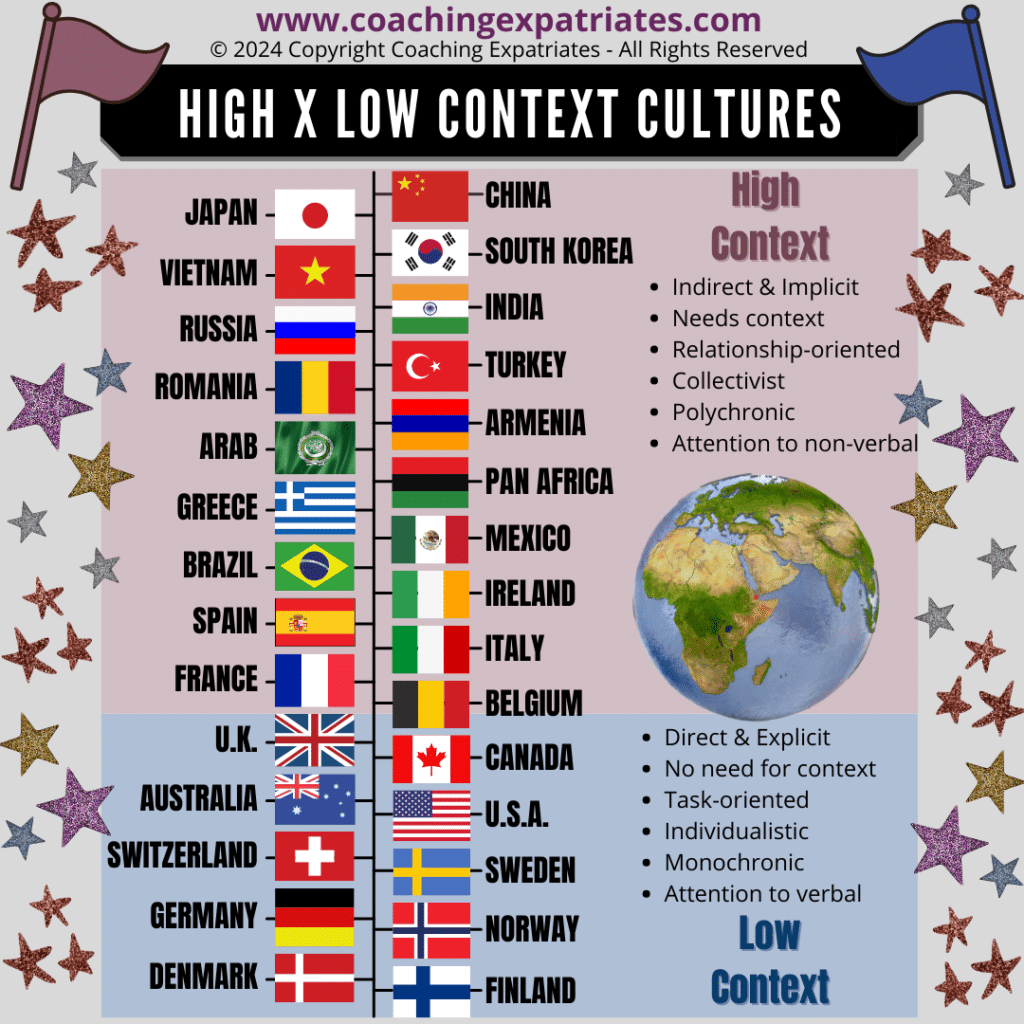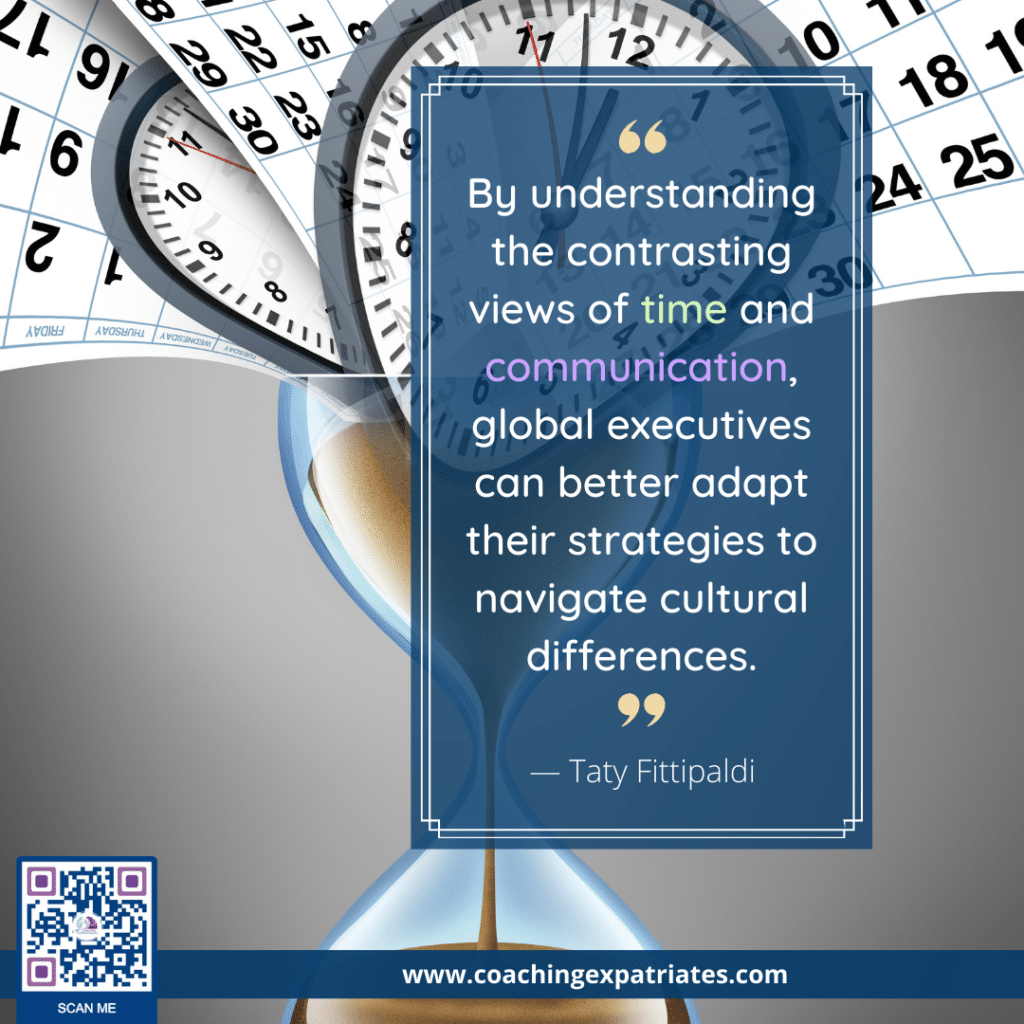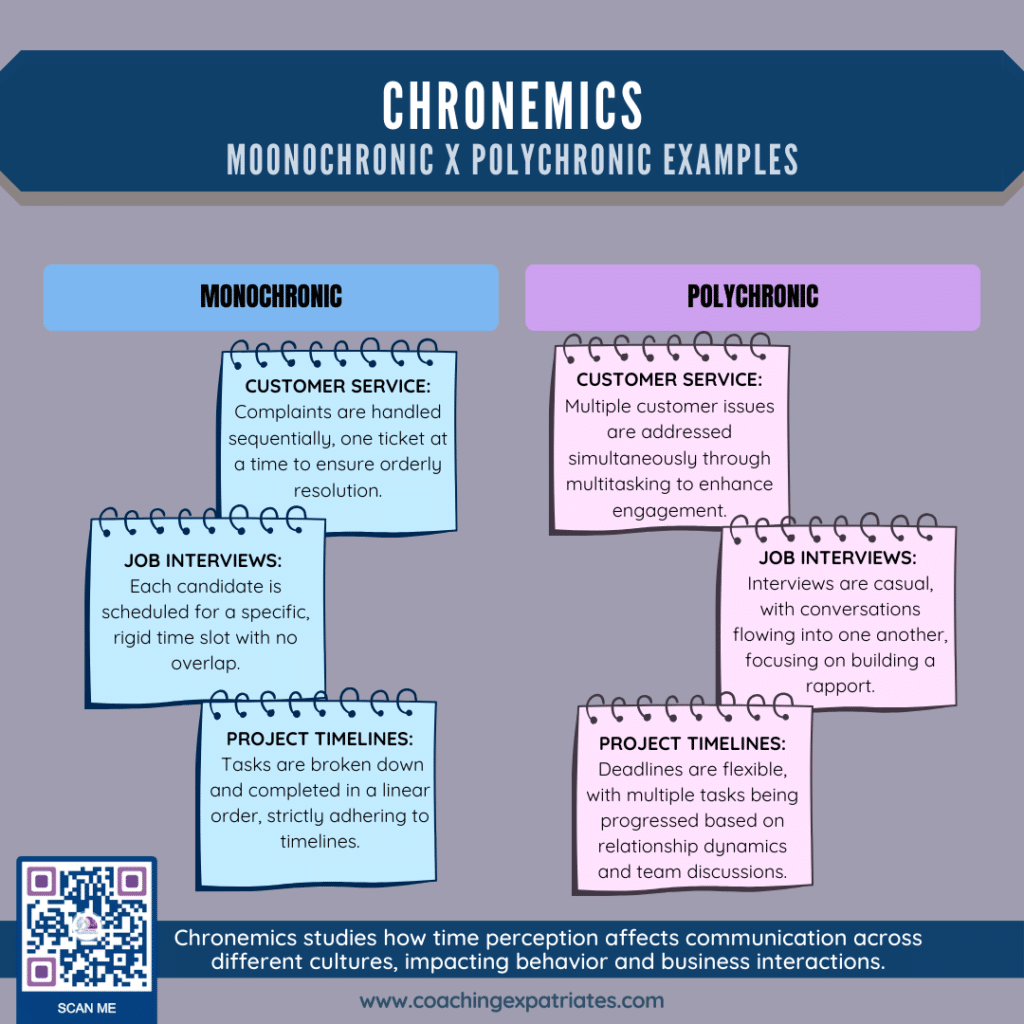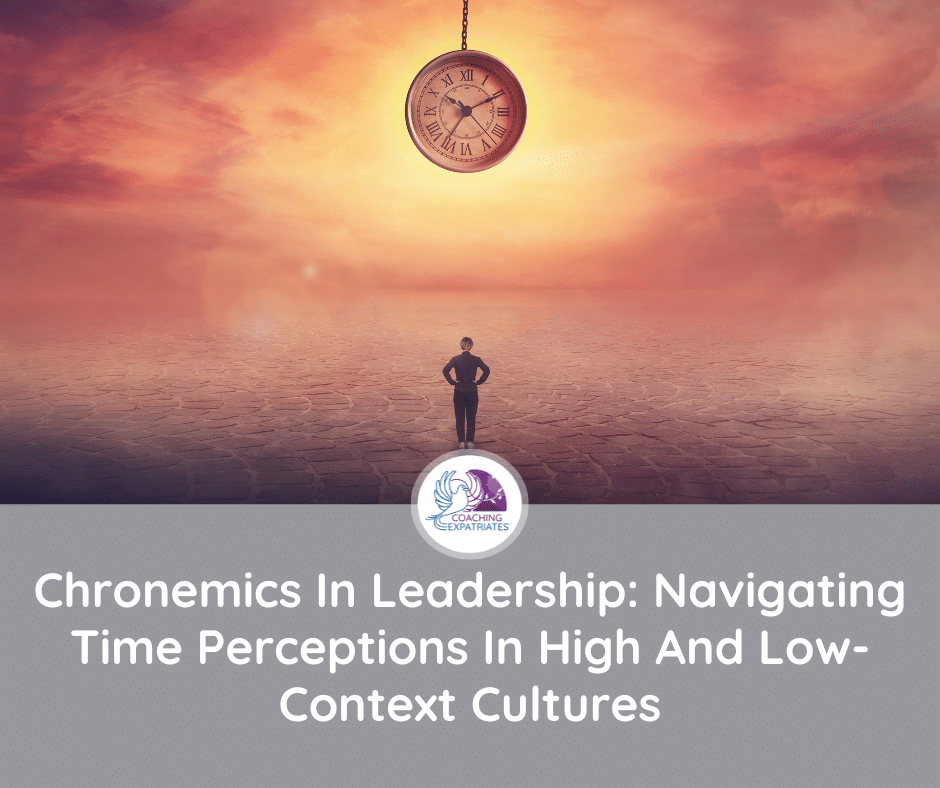In the intricate world of global business professional settings, time is more than just a ticking clock; it’s a powerful tool that shapes the way we interact and communicate. This concept, known as chronemics, refers to the study of time and how cultures perceive and use time, playing a pivotal role in understanding intercultural communication. Leaders who grasp this concept can navigate the complexities of different time perceptions, making them more adept at managing international teams and forging stronger business relationships.
For global executives, understanding time perception isn’t just a matter of scheduling or effective time-zones management. It helps create culturally sensitive strategies that cater to diverse teams. Leaders often face the challenge of balancing two primary chronemics styles: monochronic and polychronic. Monochronic cultures value structure, scheduling, and completing tasks one by one. Meanwhile, polychronic cultures emphasize relationships, multitasking, and flexibility.
Each approach has significant implications for communication and how time in communication is perceived, and high and low-context cultures have different preferences in their application.
By the end of this article, you’ll see how mastering these time-related dynamics can enhance leadership effectiveness and improve communication across borders. We’ll explore how global executives can bridge the gap between monochronic and polychronic styles, gaining a more profound understanding of high and low-context cultures while using chronemics concepts to their advantage.
Understanding Chronemics In High And Low-Context Cultures
Before diving into the influence of chronemics on communication styles, it’s essential to understand the framework of high and low-context cultures. I wrote an extensive article about communicating with High and Low-Context Cultures that provides an in-depth view of all dimensions of this theory, including chronemics. If you’re interested in a deep dive, check that out.
Defining High And Low-Context Cultures
‘High and Low Context cultures’ theory was popularized by Eduard T. Hall in his 1959 book The Silent Language and referred to the idea of how explicit a message is conveyed and/or exchanged in a culture and how important context is in communication.

This framework is crucial for understanding the varied communication styles across different cultures. Hall’s theory categorizes cultures along a continuum, placing high-context cultures on one end and low-context cultures on the other. Cultures are positioned along this dimension based on their communication styles, highlighting the differences between them. Recognizing these differences is essential for effective cross-cultural communication, enabling individuals and organizations to navigate international environments more successfully. Other theories that have similar cultural understanding objectives, like The Lewis Model and The Culture Map, also leverage many of these ideas.
High-context cultures, often found in parts of Asia, Africa, the Middle East, and Latin America, rely heavily on implicit communication. Here, people share information through non-verbal cues, body language, and the broader context of conversations. Interpersonal relationships and shared experiences shape understanding, and communication is often indirect, leaving room for interpretation. Relationships are more important than the tasks themselves in these kinds of cultures, so communication often focuses first on people, and not the activity. Space is viewed as communal, and therefore, they might interact closely with each other, leading to accidental touches, including eventually using different types of touch. Direct eye contact is not often viewed as a definitive sign of attention and respect; sometimes, it is just the opposite. For example, in certain Asian cultures like Japan, subordinates often talk to authoritative figures, not looking into their eyes as a sign of respect for authority. They might even tilt forward their heads a little as well, as another cue for respect.
In contrast, Low-context cultures are often found in Western cultures, like those in North America, Northern Europe, and Australia, which tend to be more explicit. Communication is clear, direct, and specific, with less reliance on unspoken cues or the context in which the communication is taking place. People value transparency and clarity, ensuring that messages are straightforward so everyone knows precisely what’s being said and expected. Tasks are more important than personal relationships in these kinds of cultures, so communication is often focused first on accomplishing the task, and not on people or the context that the task is related to. Personal space is of great importance. It is still considered an intimate space that should not be invaded without invitation. Therefore, these cultures have a preference to interact at certain distances and without any physical touches, sometimes even in personal settings. Direct eye contact is highly valued and is a demonstration of respect and attention as a regular social norm.

The Impact Of Cultural Context On Time Perception
These differences in communication styles heavily influence how cultures perceive periods of time in social situations. High-context cultures typically have a more fluid and flexible perception of time. People often prioritize relationships and personal interactions over rigid scheduling. Meetings and appointments may not start or end precisely on time, but the flexibility allows for deeper relationship-building. People in these cultures tend to be seen as more relational and wordy.
On the other hand, low-context cultures approach the role of time in a more structured and sequential manner. Punctuality and quick responses are crucial, and time is viewed as a resource to be allocated efficiently. Meetings adhere strictly to schedules, and people often focus on achieving specific objectives within a designated time frame. People in these cultures tend to be viewed as more transactional and blunt.
By understanding the contrasting views of time and communication, global executives can better adapt their strategies to navigate cultural differences. This insight enables them to foster clearer communication, respect cultural norms, and build more cohesive, productive teams across various time perceptions.

Monochronic Vs. Polychronic Communication Styles And Behaviors
Now that you know how high and low-context cultures usually operate, let’s connect the dots for you with the concepts of chronemics and their 2 styles of perceiving time.

Monochronic Time Orientation
Monochronic time orientation is characterized by a linear, task-oriented approach, where activities are scheduled and completed one after another and with future orientation. Monochronic orientation is prevalent in low-context cultures like North America and Northern Europe. Here, time is perceived as a finite resource, emphasizing schedules, punctuality, and strict adherence to deadlines. People value efficiency and prioritize tasks sequentially, with interruptions generally seen as counterproductive.
In business communication, monochronic cultures rely on well-defined agendas, detailed planning, and time management to ensure each activity or meeting starts and finishes as scheduled. Meetings focus on achieving specific goals, and promptness is considered professional and respectful. Monochronic-oriented workplaces often require clear timelines for project milestones and deliverables, ensuring everyone is aligned in reaching business objectives.
Polychronic Time Orientation
In contrast, polychronic time orientation is flexible and adaptable, allowing for multitasking and prioritizing relationships over strict scheduling, even in professional contexts. This relaxed approach is common in high-context cultures such as Latin America, the Middle East, and parts of Asia. People view time as a fluid concept, and activities often overlap or occur simultaneously. In these cultures, fostering strong relationships takes precedence over rigid timelines, making flexibility a core value.
In business communication, this polychronic style emphasizes adaptability and relationship-building. Meetings might not always start or end promptly, as conversations often include personal exchanges and spontaneous interactions. Leaders in these environments prioritize understanding each participant’s needs and concerns, even if it means deviating from the original agenda. Multitasking is common, and being interrupted during a meeting isn’t seen as disruptive but rather as a natural part of human communication.
By understanding these distinct approaches to time rules, global executives can better navigate the business landscape across cultures. Recognizing the importance of schedules in monochronic cultures or the emphasis on relationships in polychronic environments helps leaders build effective strategies for managing projects, negotiations, and diverse teams, as you’ll see in the examples below. It fosters mutual respect for different perspectives, ultimately contributing to smoother cross-cultural interactions.

Cross-Cultural Leadership: Bridging Time Perception Gaps
Bridging time perception gaps in teams is crucial for enhancing collaboration and performance, as different time orientations often lead to misunderstandings and friction that can hinder productivity. When global teams with monochronic and polychronic styles work together, contrasting expectations regarding deadlines, meeting structures, and communication can result in delays and missed opportunities. By recognizing and addressing these differences, leaders can align team members on project timelines, negotiation strategies, and meeting protocols. This not only minimizes miscommunication but also builds a foundation of trust and mutual respect, empowering teams to work more cohesively and efficiently toward shared goals.

Let’s explore the challenges that can arise in bridging these gaps, followed by strategies to effectively overcome them.
Challenges Faced By Global Executives
Global executives frequently grapple with challenges arising from differing time orientations across cultures. Miscommunication can easily occur when monochronic and polychronic styles collide. For instance, leaders from monochronic cultures may become frustrated by perceived tardiness or a lack of focus in meetings with polychronic counterparts. Conversely, those from polychronic cultures might find the strict adherence to agendas and deadlines in monochronic environments to be stifling and inflexible.
Here are some other potential challenges that chronemics preferences may create:
- Project Timelines:
Differences in time orientation can lead to delays. In monochronic cultures, strict adherence to schedules is crucial, but in polychronic cultures, relational interactions often take priority.
Example: A team from the U.S. might be frustrated with a team from Brazil if deliverables are postponed due to social commitments or multitasking.
- Negotiation Tactics:
Cultural disparities can result in stalled negotiations. Monochronic cultures often focus on efficiency and closing deals swiftly, while polychronic cultures emphasize long-term relationship-building.
Example: A German manager might be perplexed when negotiations with a Mexican partner drag on because the latter prefers building trust before discussing contracts.
- Meeting Management:
Diverging expectations can disrupt meeting structures. Monochronic participants prefer organized agendas and punctuality, whereas polychronic attendees might see strict scheduling as limiting.
Example: A Swedish executive may find meetings with their Saudi Arabian counterparts challenging, as they include spontaneous interactions and may not start or end on time.
These challenges illustrate the importance of recognizing and adapting to different time perceptions in cross-cultural leadership.

Practical Strategies For Effective Communication
To bridge these time perception gaps, global executives must develop strategies to enhance communication and foster mutual understanding. One approach is to adapt communication styles to align with the audience’s time orientation. Leaders should observe and mimic their counterparts’ approach to scheduling, relationship-building, and priority-setting, helping build rapport and reduce miscommunication.
Additionally, building flexibility into project timelines can accommodate diverse expectations. This flexibility ensures deadlines account for cultural variations and allow buffer periods for unexpected delays or adjustments. In meetings, executives can incorporate a mix of structured agendas and open dialogue to meet the needs of both monochronic and polychronic participants.
Some valuable skills in this exercise are:
- Active Listening: This involves understanding not just what is being communicated but also how it is presented, reflecting respect for cultural nuances. In monochromatic cultures active listening is done without interruptions, while in polychromatic cultures interruptions are expected, especially with interjections showing you are paying attention and fully engaged, like “hu-hum” or “yes, I hear you.” or “of course” or “makes total sense.”
- Interpreting Nonverbal Cues: Nonverbal communication can often convey more than verbal messages, particularly in high-context cultures. In monochronic cultures, cues like taking notes or looking people in the eye while they speak are expected. In contrast, polychronic culture cues might include nodding and gesticulating to show support, engagement, and agreement.
- Adapting Communication Styles: Tuning communication to monochronic or polychronic preferences enhances understanding, leading to reduced conflicts. This includes when multicultural teams are present, and you have to tackle both communication styles at the same time. Experienced global executives will probably start by addressing monochromic people to grab their attention, and then give a special fluid time during the meeting for debates or interruptions for polychromic people. Getting to know each team member and their preferences is key for this adaptation to happen effectively.

By understanding and embracing these differences and preferences, global executives can lead more effectively across borders. They can build stronger, more cohesive teams, improve negotiations, and ensure that projects are completed on time and with the intended impact.
Applying Chronemics Concepts To Leadership Development
Let’s make this more tangible for you by discussing how we can improve ourselves with these new concepts in mind and how to really start applying some of these concepts in our day-to-day situations.
Developing Cultural Awareness And Sensitivity
To apply chronemics concepts effectively, leaders must first cultivate cultural awareness and sensitivity. This process can be facilitated through training programs that emphasize understanding different time orientations. Such training helps leaders grasp the underlying values that shape how cultures perceive time. Beyond education, self-reflection is crucial, as leaders must recognize their own biases and preferences. By doing so, they can better adjust their behavior and communication styles to navigate cross-cultural interactions successfully.
I once coached a nurse practitioner who had relationship issues with another nurse who was being trained under her. Upon investigation, we found out that she disliked the frequent interruptions from this training nurse. She viewed these constant interruptions as annoying and disrespectful when the training nurse really wanted to show her engagement and respect for what the nurse practitioner was saying. Guess who was monochronic and polychronic in this relationship? If you said the nurse practitioner is monochronic and the training nurse is polychronic, you were absolutely right!
Once all involved developed more cultural awareness and sensitivity, they started to bridge their gaps and significantly improve their relationship. If you have a relationship issue that involves 2 different cultures, start by investigating what each behavior really means in each culture before labeling the behavior as annoying.
Enhancing Team Collaboration And Efficiency
Once leaders become more aware of their own and others’ time perceptions, they can start fostering better collaboration within their teams. This begins by encouraging open communication to clarify expectations around time. Leaders should create an environment where team members can voice their concerns about meeting structures, project deadlines, and workflows.
Additionally, designing inclusive meeting structures can help account for various time orientations. Monochronic team members will appreciate clearly defined agendas and timelines, while polychronic participants will value flexibility for relational exchanges and multitasking. Such adjustments foster mutual respect, allowing diverse teams to work more cohesively.
Examples Of Chronemics In Leadership Around The World
- China: In China, significant decisions often occur outside the boardroom through informal gatherings like dinner meetings. The official boardroom session is usually a formality, as decisions are already made during these social interactions. Understanding this dynamic helps leaders influence outcomes more effectively, recognizing that time fluidity and multitasking during negotiations are crucial. By participating in these pre-meeting discussions, leaders can build trust and gain insight, ensuring that the boardroom meeting confirms the desired decisions.
- Japan: In Japanese businesses, consensus-building (nemawashi) is crucial before formal meetings. Leaders carefully consult stakeholders individually, incorporating their feedback into the final decisions. However, obtaining this feedback often requires relationship-building through informal gatherings, such as drinks or karaoke. While business discussions may not occur directly during these occasions, the social interactions help gather valuable insights and foster trust over time. Information and feedback collection might need a bit more time-investment and legwork than monochromic cultures might want. However, this approach ensures that all stakeholders are consulted and aligned, promoting harmony and collective support before the official meeting. The result is a smoother decision-making process that reflects everyone’s input.
- United States: American business culture, rooted in monochronic principles, often prioritizes efficiency and directness. Leaders emphasize clear agendas and punctuality to ensure meetings are productive. Negotiations are typically fast-paced and objective-oriented, which suits industries where speed and innovation are vital.

These examples demonstrate how aligning leadership styles with each culture’s time perceptions can yield positive results. Understanding these nuances allows global leaders to communicate more effectively, negotiate strategically, and build stronger teams, ensuring success across diverse business landscapes.
Extra Reading Resources & Recommendations
The Silent Language
By Edward T. Hall (1959)
- Description: In this pioneering book, Edward T. Hall lays the foundation for understanding cultural perceptions of time, or chronemics. Hall explores how different cultures approach time and space and how these factors influence communication and behavior in professional settings.
- Relevance: This book is crucial for executives as it introduces the concept of high-context and low-context cultures, helping leaders navigate international business environments effectively.
Kiss, Bow, or Shake Hands: The Bestselling Guide to Doing Business in More Than 60 Countries
By Terri Morrison and Wayne A. Conaway (2006)
- Description: This book serves as a guide to cultural norms around the world, including how time perception differs across cultures. It provides practical advice on how to conduct business effectively and respectfully in various international settings.
- Relevance: For global executives, understanding the nuances of chronemics discussed in this book can enhance their communication skills and improve multinational negotiations and operations.
When Cultures Collide: Leading Across Cultures
By Richard D. Lewis (1996)
- Description: Richard Lewis provides a thorough look at how cultural differences impact communication in business. The book covers a broad spectrum of cultural norms, including detailed discussions on how time is perceived and valued differently around the world.
- Relevance: This book is particularly valuable for executives managing cross-cultural teams, offering insights into effectively leading diverse groups by understanding and bridging cultural gaps in time perception.
These books can provide a solid foundation for any executive looking to improve their intercultural communication skills, with a specific focus on chronemics.
Final Remarks On Chronemics
Chronemics offers key insights into intercultural communication that are invaluable for global leaders. By understanding the distinct time orientations of high and low-context cultures and the implications of monochronic and polychronic communication styles, leaders can bridge communication gaps and cultivate stronger relationships within diverse teams.
Applying chronemics concepts to leadership practices enhances the ability to navigate the nuances of international business. Leaders who develop cultural awareness and sensitivity are better equipped to adapt their styles, build inclusive meeting structures, and foster open communication. By acknowledging different time perceptions and adjusting their approaches, executives can build trust, improve negotiations, and ensure projects run more smoothly.
As a final tip, global executives should remember that effective communication is rooted in respect for diversity. Being open to learning and adapting their strategies helps cultivate meaningful relationships across borders. By embracing the fluidity of time in some cultures and the structured scheduling in others, leaders can create a harmonious and efficient global workplace that thrives on collaboration and shared goals.
If you are looking for a leadership development partner and consultant to help you improve multicultural interactions within your multicultural team or workforce, while implementing some of the ideas from this post, you can hire me as your executive and professional growth coach. Have a Free Strategy Call with me. We will go over your specific situation and devise together a methodical but fun way to implement these ideas and catapult your team’s performance and collaboration.
If you are interested in developing specific global leadership skills, personally or team-wise, check out our online Global Executive Leadership program. We go over all The Global Leadership Pillars™ during 9 online modules, specially meant for global leadership development. It’s a unique leadership training methodology that will change the way you think, relate, and strategize as a global leader. You can also subscribe to our free global leadership podcast, The Leadership Nest.
If you enjoyed this post, consider subscribing to our newsletter using the form below. We focus on providing good content to global leaders and executives who want to make impactful business decisions and be more inclusive and influential. We know your inbox is sacred, so we email just once per week, and we never sell, rent, or do anything funky with your information. Trust is the basis of Global Leadership, and we fully honor it.







